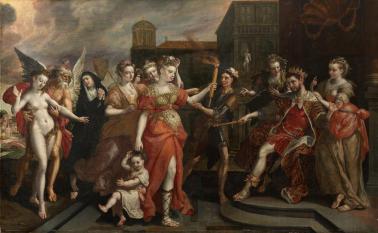
For the re-opening of the Royal Museum of Fine Arts in Antwerp (KMSKA), the collections' presentation shall be enhanced with a number of unique works on loan. One of the loans, The Calumny of Apelles by Maerten De Vos, from a foreign private collection, has never before been exhibited. The public can already discover the work now in the Rubenshuis.
The Calumny of Apelles by Maerten De Vos (1532-1603) is a unique work: it is the only known painted depiction of the subject amongst the paintings of the Southern Netherlands. Apelles, a painter from Greek antiquity, was falsely accused by a competitor of political conspiracy; however, this slander campaign was promptly squelched. In antiquity and again since the Renaissance, the artist was considered as the personification of the accomplished painter. As such, contemporaries of Rubens praised him as ‘the Apelles of his time'. The subject was especially popular with Italian artists. In our regions, we only know of one drawing by Pieter Bruegel as a predecessor. However, between this drawing and the painting by De Vos, there is no stylistic connection.
The 16th Century in Antwerp was a turbulent time of political and religious disputes. From his early work it seems that De Vos was clearly reformed. However, after the Fall of Antwerp (1585), the artist revealed himself to be a celebrated painter of large, Catholic altarpieces. Up until his death, he ardently propagated the pro-Catholic message in his work.
Maerten De Vos painted The Calumny of Apelles during the last nine years of his life. In 1594, for the Joyful Entrance of Ernest of Austria in Antwerp, he took part in the decoration of the city. The Print Room of the Museum Plantin-Moretus houses seven preparatory sketches from the artist for the city's decoration. The likeness with some of the figures from the Calumny raises the presumption that he reused the drawings in the paintings of this panel.
The allegorical and profane thematic and the presence of a completely naked figure (Truth), make the painting an exceptional and, moreover, intriguing work within the late oeuvre of the artist. The question arises of whether by means of this work this was not a debate by the meanwhile aged De Vos against the Catholic Spanish authority. In addition to this possible insinuation, the work could also contain a message of hope with the entrance of the new viceroy. As such, De Vos portrays himself on the one hand as a learned Renaissance artist with knowledge of antiquity, and on the other hand as an engaged artist who takes part in the socio-political debate through his works of art.
The patron of the work is not known. The judicial theme and the large measurements of the panel (111x180cm) could indicate a public destination such as a courtroom. However, a wealthy individual with an interest in ancient times and with possible Lutheran sympathies could also be considered as an original owner.
After centuries of remaining in private collections, The Calumny of Apelles is now accessible to the public in the Rubenshuis. Manfred Sellink, General Director-Head Curator of the KMSKA says: ‘We are especially enthusiastic that this exceptional work by Maerten De Vos shall enhance the collections' presentation at the re-opening of the KMSKA in the Spring of 2019. Behind the scenes, our curators are fully engaged with the plans of the refurbishment of the new museum. Beginning in the Autumn of 2019, the KMSKA opens up with a large exhibition that is specifically dedicated to the century of Bruegel, in particular the art of painting in Antwerp in the 16th Century. The masterpiece by Maerten De Vos shall also constitute a part of this exhibition.'
